
Pitalkhora was an early Buddhist site, similar in age to
Ajanta; it has first century BC sculpture remains, and fifth century painting
remains. The story of Pitalkhora is shrouded, but the site has yielded many
unusual sculptures, including wonderful yaksa figures.
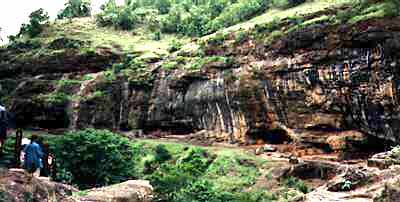
Pitalkhora, right bank, general view
of cave remains. There are several viharas and a caitya hall, with bits
of sculpture and paint.
Little remains at Pitalkhora today. The cliff has fallen
away dramatically since antiquity, and most of the carvings that existed
on the face of the cliff fell with it. Careful viewing of the cliff reveals
only scraps remaining intact (at the top right of the above photograph,
look close- there are some caitya windows.) Most of the caves are in very
poor preservation. There are a few bits here and there.
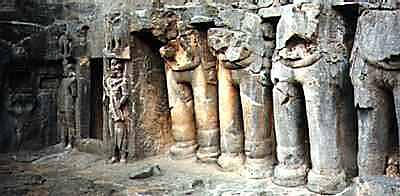
Pitalkhora's main gate, with its
naga, door guardians, and elephants.
The main gate to the site from the gorge consists of a
wide terrace, with the naga and guardians flanking the door, and a row of
elephants "supporting" the complex. There is also a stair leading
directly to the caitya. The area had covered drains, a complex of viharas,
a caitya hall, and two smaller caves across the gorge with stupas in them.
 Remains of an elephant's
head at Pitalkhora.
Remains of an elephant's
head at Pitalkhora.
The sculptural remains at Pitalkhora include animal motifs, miniature
caitya windows, the elephants and guardians, and yaksa figures.
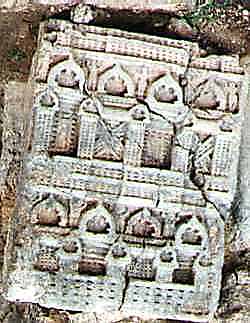
Slab on the terrace at Pitalkhora,
showing miniature caitya windows.
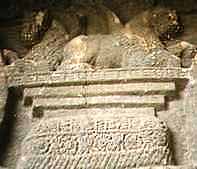
Winged animals in a vihara at Pitalkhora.
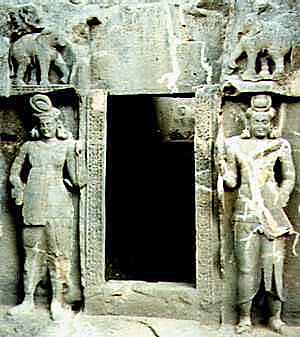 Entering Pitalkhora through the gate, you arrive
at several large vihara remains. The walls of the viharas were often made
too thin, and have mostly broken away. Weaknesses in the cliff itself, seen
in large cracks in the back walls of cells, attests to the demise of Pitalkhora
since antiquity.
Entering Pitalkhora through the gate, you arrive
at several large vihara remains. The walls of the viharas were often made
too thin, and have mostly broken away. Weaknesses in the cliff itself, seen
in large cracks in the back walls of cells, attests to the demise of Pitalkhora
since antiquity.
The Gate at Pitalkhora, with door guardians.
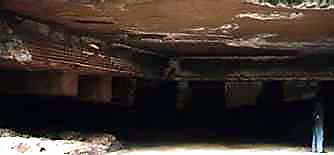
One of the viharas of Pitalkhora,
with the walls broken away. It is likely that the people building Pitalkhora
were unfamiliar with stone, thus making the walls far too thin; or perhaps
the cliff was much weaker than anticipated.
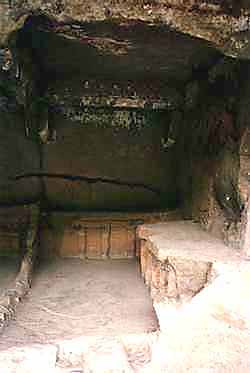
A cell in Pitalkhora. In the large viharas, the
cells are carved with elaborate moldings, and often include beds of the
living rock, some carved like these. The large crack in the back of the
wall attests to the weakness of the cliff stone.
The elaborate carving above doors, in cells, and around common rooms
may be a mark of the wealth of the community, or of its patrons. There is
much more such carving at Pitalkhora than at Ajanta.
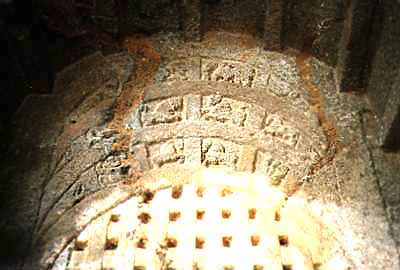
Carving over a door in a vihara at
Pitalkhora- images include lattice and common animal motifs of horse, bull,
elephant, and lion, as well as fantastic animals.
The caitya of Pitalkhora is also crumbling. Many of the
pillars have been replaced with cement to prevent collapse. The surviving
pillars have remains of fifth century paintings, similar to late painting
at Ajanta.
Painted pillars in the caitya at Pitalkhora.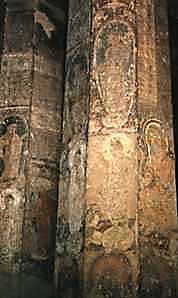
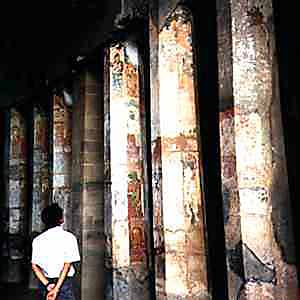
The painted pillars of the Pitalkhora
caitya. The cement blocks of a replacement pillar are in the center.
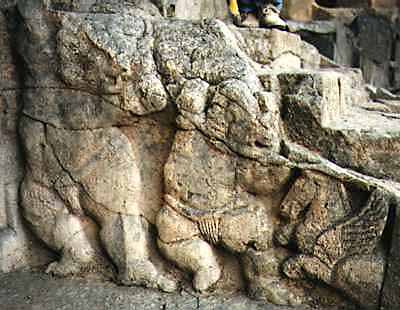
Steps from the terrace to the caitya
with yaksas and pegasus, Pitalkhora.
The caitya was reached by its own steps from the terrace,
and is flanked by viharas. To the right are smaller viharas, mostly in ruinous
condition; to the left are the larger, carved viharas.
Across the gorge from these remains are three little caves,
with stupas inside. One is a small caitya hall.
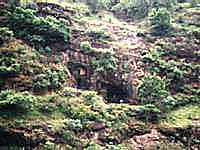 The two stupa caves at Pitalkhora.
The small caitya hall is below and to the right of this photograph.
The two stupa caves at Pitalkhora.
The small caitya hall is below and to the right of this photograph.
The stupas in these caves are very interesting. They are about twice
human height. There are several in the cave to the right in this photograph.
They are not apparently monolithic with the cave, but moved into the niches
provided for them.
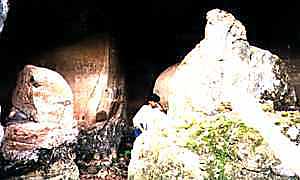
The right stupa cave. Remains of a stupa to the
left, in a niche; remains of a stupa in front, observable from across the
gorge, but half crumbled away; and a third stupa seen peeking behind, in
fair preservation.
The stupas do not match carving around them; parasols carving in the
ceiling are not centered on the stupa below. We suspect that these were
reliquaries for important community monks, added to the caves as important
persons died.
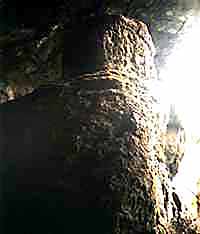 The crumbled front stupa
in the right stupa cave.
The crumbled front stupa
in the right stupa cave.
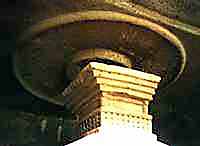
The parasol over the better preserved
stupa in the right stupa cave, not centered over the stupa itself.
Unfortunately, I do not have photos of the other caitya,
or the other caves or viharas. If you would like to share your photographs
of Pitalkhora, or sculptures removed from the site, please
contact me.
 See the site of
Ajanta itself!
See the site of
Ajanta itself!




 Remains of an elephant's
head at Pitalkhora.
Remains of an elephant's
head at Pitalkhora.

 Entering Pitalkhora through the gate, you arrive
at several large vihara remains. The walls of the viharas were often made
too thin, and have mostly broken away. Weaknesses in the cliff itself, seen
in large cracks in the back walls of cells, attests to the demise of Pitalkhora
since antiquity.
Entering Pitalkhora through the gate, you arrive
at several large vihara remains. The walls of the viharas were often made
too thin, and have mostly broken away. Weaknesses in the cliff itself, seen
in large cracks in the back walls of cells, attests to the demise of Pitalkhora
since antiquity.





 The two stupa caves at Pitalkhora.
The small caitya hall is below and to the right of this photograph.
The two stupa caves at Pitalkhora.
The small caitya hall is below and to the right of this photograph.
 The crumbled front stupa
in the right stupa cave.
The crumbled front stupa
in the right stupa cave. 
 Return to the
Ajanta Site Seminar Page!
Return to the
Ajanta Site Seminar Page! See the site of
Ajanta itself!
See the site of
Ajanta itself!